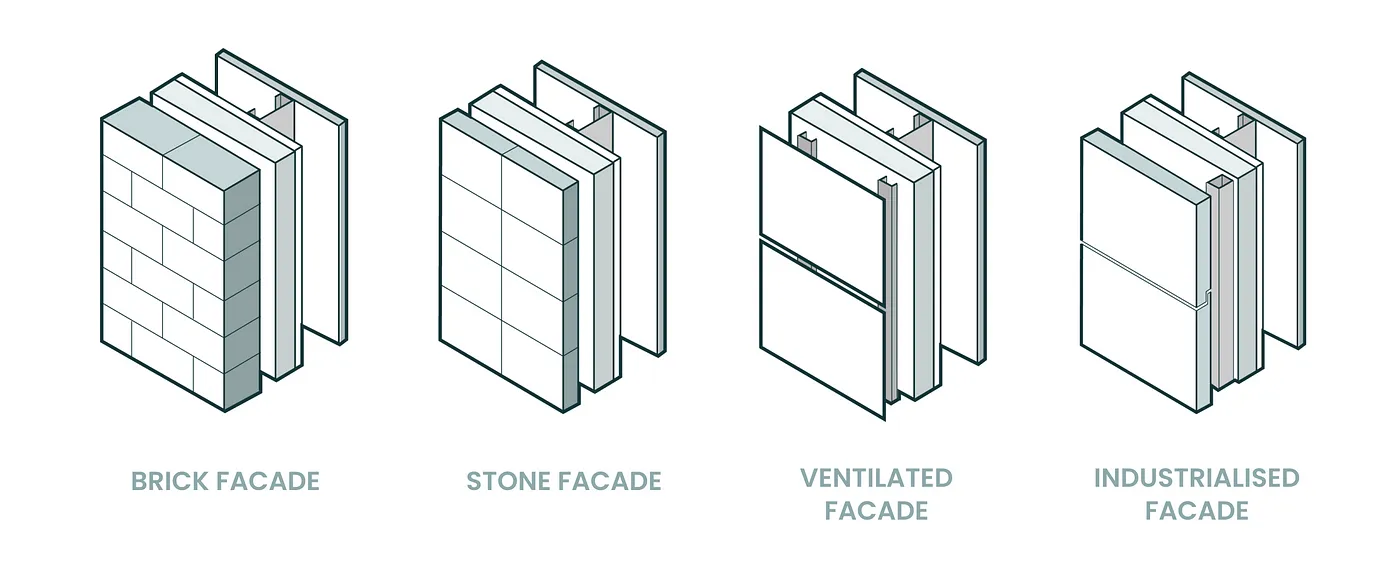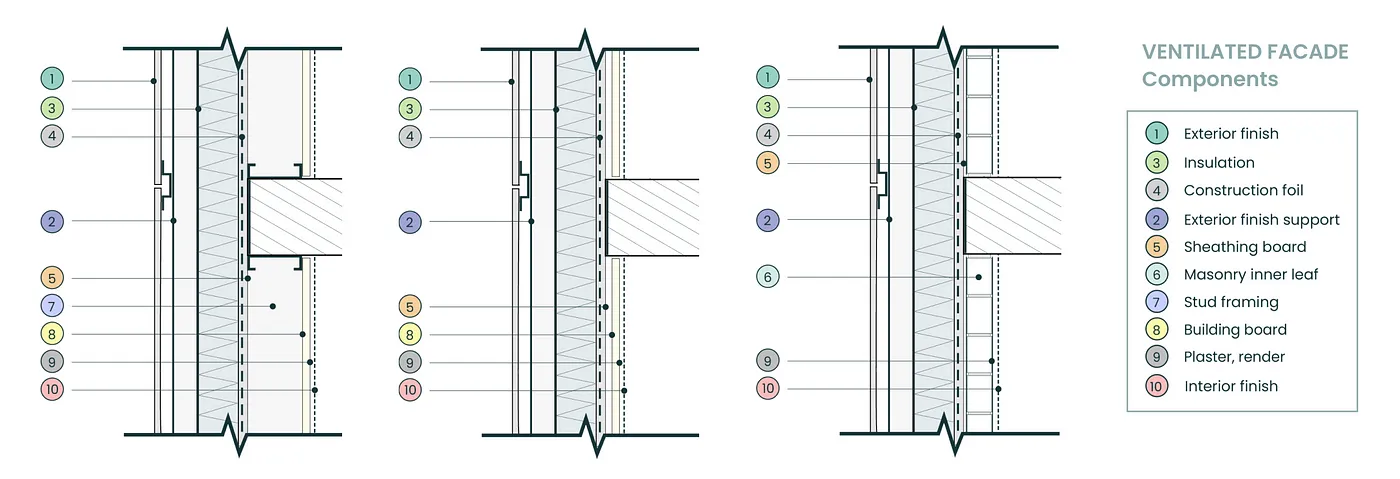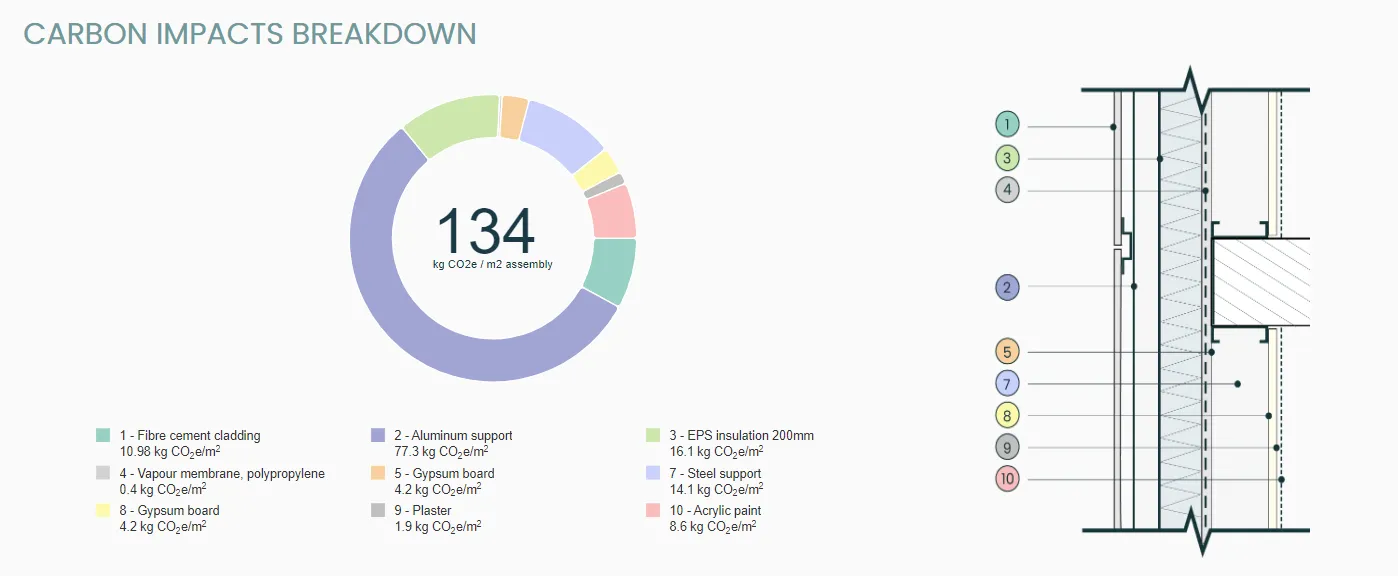Discover Embodied Carbon Optimizer tool for Building Assemblies with 2050 Materials

Embodied Carbon Optimizer is a visual tool developed by 2050 Materials that provides a simplified LCA for early design phases to quickly compare the climate impacts of building systems, like facades and roofs, by customizing standard assemblies per component.
The tool aims to be interactive to ease the translation of material choices into simplified constructive details while navigating through dynamic environmental impact breakdowns displayed per material and system.
In this climate emergency, it is crucial to accelerate the transition of the AEC industry into regenerative and low-carbon standards. More than ever, open digital data and tools are the best allies for architects and designers.
Multiple assemblies, multiple material choices

One of the aims of the tool is to study real scenarios in the pre-design phases when configuring building systems. Hence, versatility and multiple choices of materials per envelope component are key. Each system has been simplified into 10 standardized components per function within the assembly: Exterior finish, Exterior finish support, Insulation, Construction foil, Sheathing board, Masonry inner leaf, Stud framing, Building board, Plaster/render, and Interior finish.
This multiple-choice option for building materials is also translated into various simplified constructive details by offering 12 assembly configurations per facade system.

Example of constructive details for Ventilated Facades.
Easy steps to use the Embodied Carbon Tool
- Enter 2050 Materials tools page.
- Select a type of system: External walls.
- Select a facade assembly: Brick Facade, Stone Facade, Ventilated Facade or Industrialised Facade.
- Select the specific building materials by displaying the menu per component: Exterior finish, Insulation, Construction foil, etc.
- Check the environmental impact results simultaneously while you are changing your material choices.
LCA Methodology
Life-cycle assessment / LCA (also known as life cycle analysis) is a methodology for assessing environmental impacts (including embodied carbon) associated with all the stages of the life cycle of a system (whole building, construction material, building assembly, etc.). LCA considers all the steps that occur during the lifetime of each system, from raw material extraction and manufacturing to distribution and usage, as well as the final disposal.
These are the specific assumptions taken to develop the Embodied Carbon Optimizer tool:
- All data is based on Environmental Product Declarations (EPD) covering the manufacturing stages (life cycle phases A1–A3). Quantities are based on average data for a standard building envelope per m2.
- This tool is fully customizable with importing capabilities for Bills of Quantities, alternative sector targets and bespoke product databases for real facade and roof scenarios.
- The Warming Potential is a forward-looking metric designed to show the temperature alignment of the selected design based on the required reductions as described in the 2021 UNEP Gap report.
- The Embodied Carbon Optimizer tool was created using open-source environmental impact data and average schedules for envelope assemblies.
Environmental impact results
The results provide data about specific environmental metrics for A1-A3 phases per m2 of assembly:
- Carbon footprint (GWP). Greenhouse gas emissions related to raw material extraction (A1), transport to the manufacturing location (A2) and production (A3).
- Stored Carbon (Biogenic Carbon). Amount of CO2 that is sequestered or captured and stored within construction materials and components, reducing their contribution to greenhouse gas emissions.
- Water footprint. Fresh water used in the manufacturing stages A1-A3 for each material chosen in the assembly.

Results for a Ventilated Facade System through Embodied Carbon Optimizer.
The results are displayed for the whole assembly (image above) and as a detailed breakdown of carbon impacts per material selected (image below).

Results for a Ventilated Facade System through Embodied Carbon Optimizer.
Take climate action with open-source tools and environmental impact data
2050 Materials, while profit-driven, is committed to democratizing sustainability data in the Architecture, Engineering, and Construction (AEC) industry. Following our leitmotiv, we share Open API and Open LCA simplified tools to widen the use of crucial environmental data.
Know more about 2050 Material’s open API here.
Contact us to find out how you can create a tool like this one, customized to your needs.
If you want to customize your own assembly and create tools like this one then get access to our Api.
Related articles

Climate-Resilient Materials for the Built Environment: A Data-Centred Prime
As climate volatility intensifies, resilience metrics are fast becoming as critical as carbon data in material selection. This article outlines why adaptation is now a design imperative, how materials can be evaluated through a systems lens, and what KPIs project teams should demand. From self-healing concrete to fire-rated façades, we present a structured taxonomy of resilient materials, explain how to embed this intelligence into digital design workflows, and propose next steps for specification, benchmarking, and procurement.
Read more
The Most Interesting Low Carbon Products in Office Design
In this article and collection, we highlight 11 outstanding products that contribute to a lower carbon footprint in office design.
Read more
Top Low Carbon Building Boards: Performance, Benefits, and Use Cases
The building boards highlighted in this article and collection showcase low-carbon innovation in modern construction.
Read more